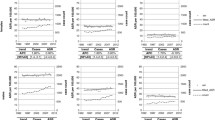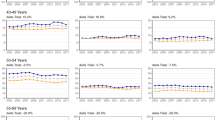Abstract
Purpose
Colorectal cancer (CRC) incidence rates have increased among young adults and have decreased among older adults. We re-evaluated these trends using more recent data covering about 96 % of the United States population.
Methods
Colorectal cancer incidence rates were abstracted from the National Program of Cancer Registries and the Surveillance Epidemiology and End Results analytic files for diagnosis years 1998–2009. We report rates for young adults (age <50 years) and for older adults (age 50 years or older) by four race/ethnicity groupings. We examined CRC incidence rates by stage at diagnosis, tumor subsite, and state. We calculated the correlation between state-specific CRC incidence and prevalence of colonoscopy reported in the Behavioral Risk Factor Surveillance System.
Results
Rectal cancer incidence rates increased from 1998 through 2009 among young non-Hispanic white adults and young blacks. Among older adults, CRC incidence rates decreased among all four race/ethnicity groupings and in all states. The decline was apparent for all stages and for all subsites. States with greater decreases in CRC incidence rates had higher colonoscopy screening rates.
Conclusion
Rectal cancer is increasing among younger adults, for reasons largely unknown. Among older adults, CRC incidence continues to decrease, probably because of increasing uptake of colonoscopy screening. Decreases in CRC incidence are correlated with increased use of colonoscopy, indicating that CRC may be largely preventable through colonoscopy screening. Efforts to increase screening rates in underserved populations would help reduce health disparities associated with this type of cancer.




Similar content being viewed by others
References
U.S. Preventive Services Task Force (2008) Screening for colorectal cancer. Recommendation statement. Oct 2008 www.uspreventiveservicestaskforce.org
Siegel RL, Ward EM, Jemal A (2012) Trends in colorectal cancer incidence rates in the United States by tumor location and stage, 1992-2008. Cancer Epidemiol Biomarkers Prev 21:411–416
Siegel RL, Jemal A, Ward EM (2009) Increase in incidence of colorectal cancer among young men and women in the United States. Cancer Epidemiol Biomarkers Prev 18:1695–1698
Surveillance Research Program, National Cancer Institute SEER*Stat software version 7.0.5. Available at: seer.cancer.gov/seerstat
National Program of Cancer Registries, United States Cancer Statistic, Centers for Disease Control and Prevention (2012) Available at http://www.cdc.gov/cancer/npcr/uscs/technical_notes/criteria.htm/ Accessed 14 Feb 2012
SEER Site Recode, ICD-O-3 (1/27/2003) Definition (2012) Available at: http://seer.cancer.gov/siterecode/icdo3_d01272003/ Accessed 19 Sept 2012
Fritz A, Ries L (eds) (2012) SEER extent of disease-1988. Codes and coding instructions, 3rd edn. National Cancer Institute 1998 available at: http://seer.cancer.gov/manuals/EOD10Dig.pub.pdf. Accessed 19 Sept 2012
Young JL Jr, Roffers SD, Ries LAG, Fritz AG, Hurlbut AA (eds) (2012) SEER summary staging manual-2000: codes and coding instructions, National Cancer Institute, NIH Pub. No. 01-4969, Bethesda, MD, 2001. Available at: http://seer.cancer.gov/tools/ssm/. Accessed 4 Jan 2012
Collaborative Staging Task Force of the American Joint Committee on Cancer. Collaborative Staging Manual and Coding Instructions, version 01.04.00: Jointly published by American Joint Committee on Cancer (Chicago, IL) and U.S. Department of Health and Human Services (Bethesda, MD), 2004. NIH Publication Number 04-5496. Incorporates updates through 8 Sept 2006
Collaborative Staging Task Force. Collaborative Stage Data Collection System, Collaborative Staging (2012) Available at: http://www.cancerstaging.org/cstage/cstageintro.html. Accessed 3 Jan 2012
Austin H, Duong LM, King J, Richardson LC, Eheman C (2012) A method to adjust for stage coding changes in the national program of cancer registries illustrated for colorectal cancer. J Regist Manag 39(2):62–68
Spiegelhalter DJ (2005) Funnel plots for comparing institutional performance. Stat Med 24:1185–1202
Centers for Disease Control and Prevention (CDC). Behavioral risk factor surveillance system survey data. Atlanta, Georgia: U.S. Department of Health and Human Services, Centers for Disease Control and Prevention, 1997, 1999, 2002, 2004, 2006, and 2008. Available at http://www.cdc.gov/brfss/index.htm Accessed 16 April 2013
StataCorp. (2011) Stata: release 12. Stata Corp LP, College Station
Wingo PA, Jamison PM, Hiatt RA, Weir HK, Gargiulla PM, Hutton M, Lee NC, Hall HI (2003) Building the infrasctructure for nationwide cancer surveillance and control: a comparison between The National Program of Cancer Registries (NPCR) and The Surveillance, Epidemiology, and End Results (SEER) Program (United States). Cancer Causes Control 14:175–193
Larsson SC, Wolk A (2007) Obesity and colon and rectal cancer risk: a meta-analysis of prospective studies. Am J Clin Nutr 86:556–565
Centers for Disease Control and Prevention (CDC). Behavioral risk factor surveillance system survey data. Atlanta, Georgia: U.S. Department of Health and Human Services, Centers for Disease Control and Prevention. Available at http://www.cdc.gov/brfss/index.htm Accessed 16 April 2013
Larsson SC, Orsini N, Wolk A (2005) Diabetes mellitus and risk of colorectal cancer: a meta-analysis. J Natl Cancer Inst 97:1679–1687
Naishadham D, Lansdorp-Vogelaar I, Siegel R, Cokkinides V, Jemal A (2011) State disparities in colorectal cancer mortality patterns in the United States. Cancer Epidemiol Biomarkers Prev 20(7):1296–1302
Shapiro JA, Klabunde CN, Thompson TD, Nadel MR, Seeff LC, White A (2012) Patterns of colorectal cancer test use, including CT colonography, in the 2010 National Health Interview Survey. Cancer Epidemiol Biomarkers Prev 21(6):895–904
Centers for Disease Control and Prevention (2011) Vital signs: colorectal cancer screening, incidence, and mortality-United States, 2002–2010. MMWR Morb Mortal Wkly Rep 60(26):884–889
National Center for Health Statistics (2013) Health, United States, 2012: with special feature on emergency care. Hyattsville, MD
Conflict of interest
No author has any conflict of interest.
Author information
Authors and Affiliations
Corresponding author
Additional information
The findings and conclusions in this report are those of the authors and do not necessarily represent the official position of the Centers for Disease Control and Prevention.
These data were provided by the central cancer registries participating in either the National Program of Cancer Registries (NPCR) (November 2011 data submission) or the Surveillance, Epidemiology, and End Results (SEER) Program (November 2011 submission).
Rights and permissions
About this article
Cite this article
Austin, H., Jane Henley, S., King, J. et al. Changes in colorectal cancer incidence rates in young and older adults in the United States: what does it tell us about screening. Cancer Causes Control 25, 191–201 (2014). https://doi.org/10.1007/s10552-013-0321-y
Received:
Accepted:
Published:
Issue Date:
DOI: https://doi.org/10.1007/s10552-013-0321-y




